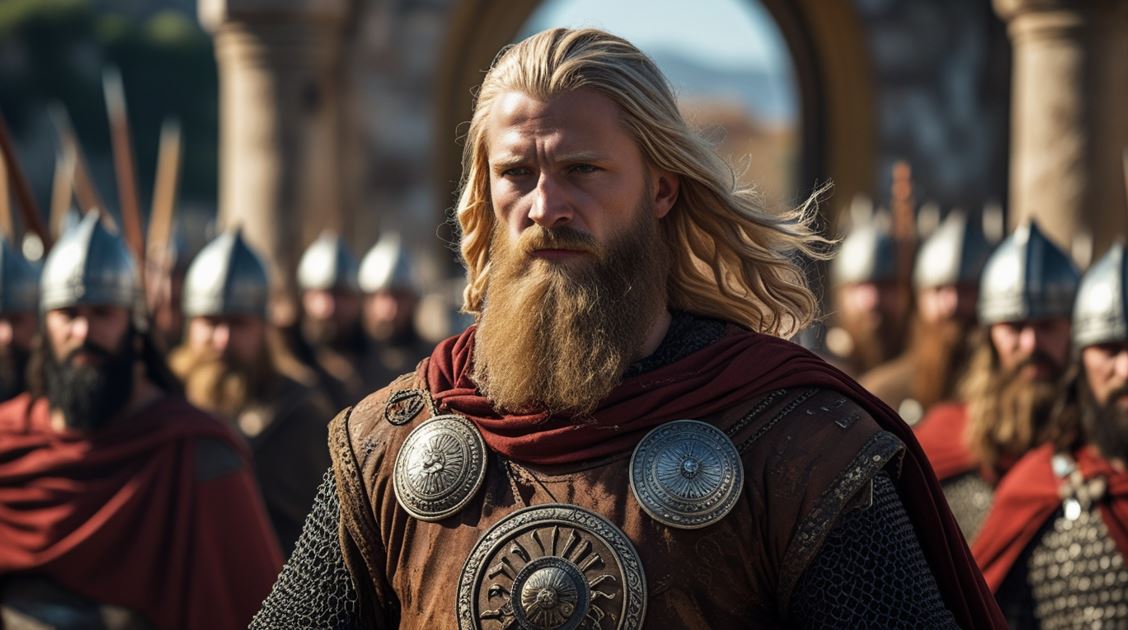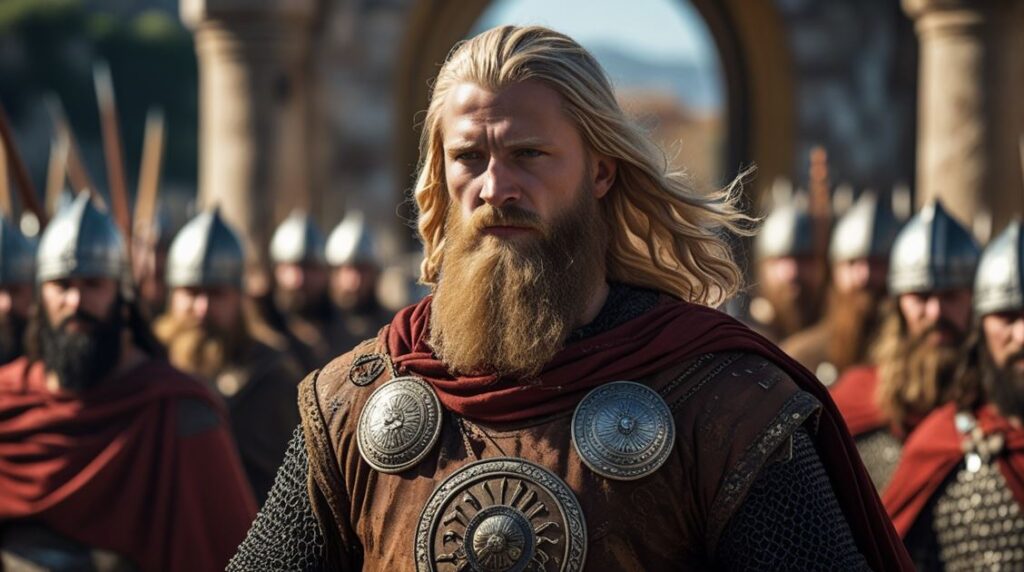After fleeing Norway as a teenage exile, Harald Hardrada had already proven himself as a mercenary captain for the Grand Prince of Kiev. But in 1035, at just 20 years old, he would embark on the most transformative chapter of his early life: service in the elite Varangian Guard of the Byzantine Empire.
- Entering the Golden City
- Baptism by Fire: Pirates and Sieges
- The Armenian Campaign and the Giant General
- Jerusalem: A Pilgrimage in Arms
- The Sicilian Adventure: Birds, Tunnels, and Coffins
- Court Intrigue: The Game of Thrones Begins
- The Riot of 1042: Revolution in the Streets
- The Blinding of an Emperor
- The Price of Success
- Further Reading
Entering the Golden City
Constantinople in 1035 was the beating heart of the medieval world – a city of unimaginable wealth and power that made even the grandest European capitals seem like provincial towns.
When Harald arrived at the Golden Horn, he was entering a world of silk-robed emperors, towering churches, and political intrigue that would make Game of Thrones look tame.
The Varangian Guard, into which Harald enlisted, was the empire’s most prestigious military unit – an elite force of largely Scandinavian warriors who served as the emperor’s personal bodyguards. These were no ordinary soldiers; they wore silk trousers, carried golden weapons, and commanded respect throughout the empire.
Baptism by Fire: Pirates and Sieges
Harald’s first taste of action came quickly.
Arab corsairs had swept into the Aegean, raiding Greek islands and carrying off civilians into slavery. For a young warrior hungry for glory and gold, it was the perfect introduction to Byzantine warfare.
What followed was a whirlwind of campaigns that would span six or seven years.
While the Icelandic sagas that preserve these stories were written centuries later and are filled with literary embellishments, they paint a picture of Harald as a warrior in constant motion – storming castle walls, leading desperate charges, and earning a reputation that would echo through the corridors of power in Constantinople.
The Armenian Campaign and the Giant General
One of Harald’s most significant early campaigns took him to the empire’s far eastern borders in Armenia, where the Byzantine army was besieging the city of Berkri on the shores of Lake Van.
Here, Harald served under George Maniakes, a Greek general who was described as “fully 9 feet tall” with “hands strong enough to make walls totter and shake gates of brass.”
The relationship between Harald and this giant commander was reportedly stormy. The sagas claim the Varangians demanded Harald be put in command instead of Maniakes – a bold move that speaks to the young Norwegian’s growing reputation and confidence.
Jerusalem: A Pilgrimage in Arms
During this period, Harald may have participated in one of the most remarkable expeditions of the 11th century. The Byzantine Emperor had negotiated with the Fatimids of Egypt to rebuild the Church of the Holy Sepulchre in Jerusalem, which had been damaged by the mad Caliph Al-Hakim in 1009.
A Byzantine expedition was sent to oversee the reconstruction, complete with architects, bishops, and a Varangian escort.
The sagas claim Harald was among them, and that he bathed in the Jordan River “in the manner of all pilgrims.” While we can’t be certain of Harald’s presence, the detail rings true – it’s exactly what a devout Christian warrior would do.
The Sicilian Adventure: Birds, Tunnels, and Coffins
Harald’s longest posting was to Sicily, where he served from about 1038 to 1041 in the Byzantine attempt to reconquer the island from its Muslim rulers. This campaign would become the stuff of legend, though separating fact from fiction is nearly impossible.
The sagas credit Harald with a series of ingenious military tricks that read like something from a medieval adventure novel:
- The Firebombing Birds: Harald supposedly had his warriors capture birds, attach burning sulfur to their feet, and release them over enemy towns. The birds would return to their nests on thatched roofs, setting the settlements ablaze. While this story has been told about various commanders throughout history, it shows how Harald’s reputation for cunning had grown.
- The Tunnel Gambit: Outside a town near Mount Etna, when the commanding general declared the fortress impregnable, Harald reportedly had his men dig a tunnel from a nearby ravine directly into the enemy’s great hall – emerging in the middle of a feast to slaughter the defenders.
- The Coffin Deception: Perhaps the most audacious tale comes from Syracuse. Unable to take the city by force, Harald allegedly faked his own death. His “grieving” comrades requested permission to hold a Christian funeral inside the city. When granted safe passage for twelve pallbearers, Harald and eleven heavily armed companions carried the “coffin” through the gates. Once inside, they dropped their burden, drew their weapons, and opened the gates for the waiting army.
While these stories are almost certainly embellished, they reflect something important: Harald was gaining a reputation as a commander who could think outside conventional military tactics.
Court Intrigue: The Game of Thrones Begins
By 1040, Harald had been promoted to the elite Manglavites, the emperor’s personal bodyguard, complete with a golden sword and special privileges. He accompanied Emperor Michael IV on campaign against the Bulgars, where his valor earned him the court rank of spatharocandidatos – an extraordinary honor for a foreign barbarian.
But Harald was about to discover that in Constantinople, military success was only half the battle.
The Byzantine court was a snake pit of eunuch advisors, ambitious generals, and deadly political maneuvering that would test all his skills.
Emperor Michael IV, who had seduced his way to power through the Empress Zoe, was dying of epilepsy and dropsy. His brother John, a eunuch who served as the power behind the throne, orchestrated a smooth succession by having Michael adopt a nephew, also named Michael, as his heir.
The Riot of 1042: Revolution in the Streets
The new Emperor Michael V made a fatal error: he turned against Zoe, the woman who represented the legitimate Macedonian dynasty.
On Easter Sunday 1042, he had her dragged from her chambers, accused her of trying to poison him, and shipped her off to a nunnery with her head shaved “as though she was a common criminal.”
Constantinople exploded.
Zoe was beloved by the people, and Michael V was seen as an upstart. What began as protests became a full-scale revolution.
The Varangians, whose loyalty was pledged to the Imperial family, likely supported the rioters. For three days, the city was consumed by street battles between Michael’s supporters and an alliance of citizens and guardsmen.
The Blinding of an Emperor
The climax came when the rebels stormed the palace through the emperor’s box in the Hippodrome.
Michael V fled by imperial yacht to seek sanctuary in a monastery. But sanctuary meant nothing to the enraged mob. They dragged him from the altar as he clung to the pillars weeping and praying to God.
What happened next was brutal even by medieval standards.
The former emperor was held down while his eyes were gouged out – the traditional Byzantine method of ensuring a deposed ruler could never return to power.
The Icelandic sagas make a startling claim: it was Harald Hardrada himself who performed this grisly task.
Whether true or not, this story reveals how far Harald had risen in just seven years. From a teenage exile, he had become one of the most powerful men in the Byzantine Empire – wealthy, influential, and feared.
The Price of Success
By 1042, Harald Hardrada had achieved everything a young warrior could dream of. He commanded the Varangian Guard, possessed enormous wealth, and wielded real political power in Europe’s greatest city.
But success in Constantinople came with a price.
Harald had learned to navigate the treacherous waters of Byzantine politics, but he had also made enemies. His rivalry with generals like Maniakes and his role in the violent overthrow of Michael V had marked him as a dangerous man.
Harald’s time in the Golden City was about to come to a dramatic end. The young exile who had arrived seeking fortune and glory would soon find himself planning one of the most audacious escapes in medieval history.
Further Reading
If you enjoyed this article, you may enjoy these:
- Harald Hardrada: From Viking Exile to Elite Byzantine Warrior
- Harald Hardrada’s Epic Journey
- Cnut the Conqueror: How a Viking Became King of England
- Blood on St. Brice’s Day: Æthelred’s Viking Massacre
- The Fear of the Year 1000: Apocalyptic Anxieties
- Tribute or Treason? Æthelred’s Gamble with the Vikings
- Kings and Queens of England Ranked from Worst to Best
- Why was the crowning of Charlemagne so important?







